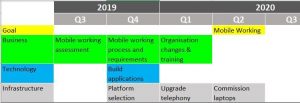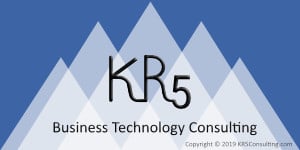A technology roadmap helps business leaders plan how it will meet its strategic business goals. Owners of scale-ups want to have key tech in place before it’s needed. So, how can owners plan what’s needed, and when, to make sure it’s done in time?
Rogan Hounsell-Roberts was a founder of a successful scale-up; has helped organisations across many sectors achieve success; a founder of KR5 Consulting; and passionate to help ambitious business leaders succeed.
In business we know that there are many moving parts, and how these often link to each other. Focusing on only one area for a long period of time can often be at the expense of another. Getting stuff done is great, but you also want it to create value, and creating value rarely happens in isolation. You could manage that in a big complex project plan. The thing about a complex project plan is that it can be inflexible, hard to resource and manage. Using a technology roadmap keeps it simple and is easier to manage.
In this three-part series, we take an in-depth look at technology plans for scale-ups. We looked at “Technology Plan: 6 Reasons Why Scale-Ups Need One” in Part-One. Part-Two “Technology Strategic Plan: The 7 Steps to Success” covered creating the plan. In this final part we look at turning that into a roadmap to make it happen.
Approach

Often the hardest part is starting when you’re faced with a blank sheet of paper. People find they have too much buzzing around in their head, and struggle to nail it down. Of course, there are different approaches to a roadmap, depending on what you’re looking for. I’ve taken a layered approach to create four swim lanes as follows:
#1 Define Layers

Firstly, I define the layers. I find this helps me get a clearer view of the moving parts. It also means I can break the task into more manageable chunks. I’ve named the top layer ‘Goals’ to represent the business outcomes. You could use something more specific, however ‘Goals’ will give you a good first version. The next layer represents the People and Processes which I’ve named “Business”. In the third layer are the technology applications to support the business. Finally, I’ve a layer for infrastructure. Some technology roadmaps might include security if that’s likely to involve significant work.
#2 Goals

This should be straightforward if you’ve followed part-two of this series. You’ll have a good idea of the business strategy and how technology fits into the plan. In the top layer, you can sequence the goals left to right to represent the timeline. This means you can see how the other layers align with the overall business direction.
#3 Business
Having set the scene with the goals, our next layer breaks down the problem further. In the ‘Business’ layer we want to explore changes for people and processes. For the roadmap this is high-level, you’re looking for the high-level building blocks. This might involve a new group, training, or a new service. How does the organisation need to change to achieve a goal? What will work look like in the future?
#4 Technology

In part-two we looked at using technology to create opportunity. Although you might not have selected anything, you’ll probably know the type of technology needed. Ideally, you’ll be working to a blueprint. In that case you’ll know the building blocks and can include the ones you need. If your view is too narrow, you can end up with point solutions. A broader view will help you use technology to reduce complexity and cost.
#5 Infrastructure

The final layer is the infrastructure. How will you run and connect to the systems? Will you run systems in the cloud, in a data centre or in an office? What will that look like? You’ll want to make sure it will securely meet the demand by design. Will you need to upgrade networks or telephone systems? Will you need to upgrade staff equipment?
Finally
Using a roadmap helps to plan work and create overview. The layered approach helps communicate how different parts relate to the business goals and encourages forward planning. A roadmap is more effective if you use it alongside a blueprint or architecture of how the technology building blocks fit together.
KR5 Consulting help business leaders achieve their vision. We want to understand what makes you and your business tick, so we can help you create solutions that really work for you. We work alongside you and your team, run workshops, analyse, design, plan, manage and deliver business solutions to power you onto your destination. Our purpose is to help you accelerate, increase profits, scale-up, acquire customers and beat the competition.
If you’d like to explore the ideas in this article further or need help and advice, please contact Rogan at rhounsell@kr5consulting.com – to arrange an informal chat.
If you’ve found this blog interesting or useful, please ‘like’, ‘comment’ or ‘share’ so it can help others too.

